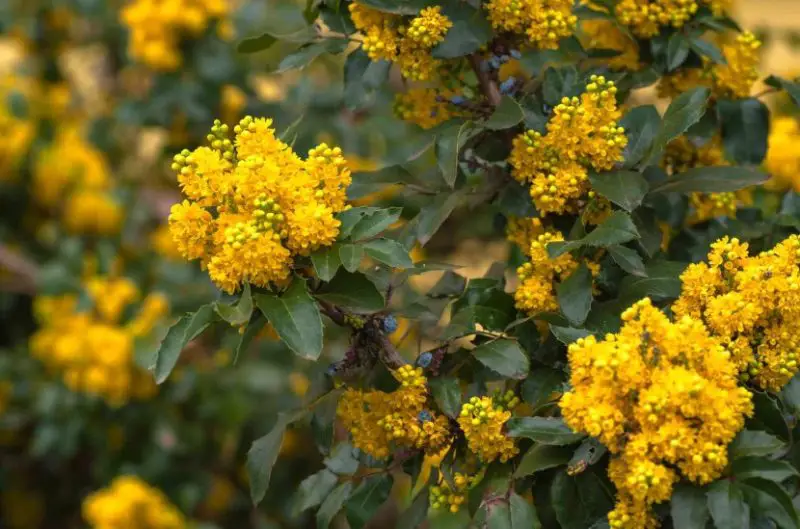Oregon Grape (Mahonia aquifolium) is an evergreen shrub known for its striking yellow flowers, holly-like leaves, and deep blue berries. Native to North America, particularly the Pacific Northwest, this plant is often used for landscaping, wildlife attraction, and medicinal purposes.
If you’re considering growing Oregon Grape, this guide will provide all the essential information to help you cultivate and maintain this beautiful and resilient shrub.
Benefits of Growing Oregon Grape

Ornamental Appeal
The plant’s glossy green leaves turn a reddish-purple in fall, adding year-round beauty to gardens. Its bright yellow flowers bloom in early spring, creating a striking contrast against the dark green foliage.
Wildlife Attraction
Oregon Grape is an excellent plant for pollinators such as bees and butterflies. Its berries also provide food for birds and small mammals.
Medicinal Uses
The roots and bark contain berberine, a compound known for its antimicrobial and anti-inflammatory properties. It has been traditionally used to treat digestive and skin ailments.
Drought Tolerance
Once established, Oregon Grape is highly drought-tolerant, making it a great choice for xeriscaping and water-wise gardening.
How to Grow Oregon Grape
Choosing the Right Location
Oregon Grape thrives in a variety of conditions, but selecting the ideal location can enhance its growth and health.
Sunlight Requirements
Oregon Grape prefers partial shade, making it an excellent understory plant. However, it can also tolerate full sun, especially in cooler climates. In hotter regions, providing some afternoon shade will help prevent leaf scorch and maintain vibrant foliage.
Soil Conditions
The ideal soil for Oregon Grape is well-drained, slightly acidic to neutral soil with a pH range of 5.5 to 7.0. It grows well in sandy, loamy, or clay-based soils, provided they do not retain excessive moisture. To improve drainage, consider adding organic matter such as compost or mulch to the soil. Avoid planting in waterlogged areas, as prolonged moisture can lead to root rot.
Climate
Oregon Grape is hardy in USDA zones 5-9, meaning it can withstand a wide range of temperatures, from cold winters to hot, dry summers. It is well-adapted to the Pacific Northwest but can also thrive in other regions with similar conditions. The plant is highly resilient and can tolerate frost, drought, and occasional neglect once established. In particularly harsh climates, adding a layer of mulch around the base can help insulate the roots and retain soil moisture.
Planting Oregon Grape
Best Time to Plant
The ideal times to plant Oregon Grape are early spring and fall. Planting during these seasons allows the roots to establish before extreme summer heat or winter frost sets in. Avoid planting during peak summer, as young plants may struggle with excessive heat and water loss.
Spacing
When planting multiple Oregon Grape shrubs, space them 3-5 feet apart. This spacing ensures adequate air circulation, reducing the risk of fungal diseases. It also allows enough room for the shrubs to grow and spread naturally without overcrowding.
Planting Depth
Dig a hole twice the width and the same depth as the root ball. Place the plant in the hole at the same depth it was in its nursery container. Backfill with the removed soil, gently firming it around the roots to eliminate air pockets. Water thoroughly after planting to help the soil settle.
Mulching
Apply a 2-inch layer of organic mulch, such as wood chips or bark, around the base of the plant. Mulching helps retain soil moisture, suppress weeds, and regulate soil temperature. Keep mulch a few inches away from the stem to prevent rot and pest issues.
Watering Requirements
Proper watering plays a crucial role in the growth and overall health of Oregon Grape, particularly during its early establishment period. While the plant is naturally drought-tolerant once mature, maintaining an appropriate watering schedule during its initial growth phase ensures the development of a strong and resilient root system.
Watering During the Establishment Phase
The first year after planting is critical for Oregon Grape as it works to establish deep, sturdy roots. During this period, consistent watering is necessary to support root expansion and prevent stress.
- Frequency and Depth: Water deeply at least once or twice a week, depending on weather conditions. Deep watering encourages the roots to grow downward, increasing the plant’s drought resistance in the long run.
- Checking Soil Moisture: Before watering, check the soil by inserting your finger about an inch below the surface. If the soil feels dry at this depth, it’s time to water.
- Weather Considerations: During hot or dry periods, the plant may require more frequent watering. However, avoid excessive watering during rainy seasons, as this can lead to waterlogged soil.
Watering Established Plants
Once Oregon Grape is well-established—typically after the first growing season—it becomes highly drought-resistant and requires minimal supplemental watering.
- Natural Rainfall Sufficiency: In regions with moderate rainfall, mature plants often thrive without additional watering.
- Dry Period Management: During extended droughts or particularly hot summers, occasional deep watering will help maintain plant vigor. Aim for a thorough soaking every few weeks rather than frequent, light watering.
- Avoiding Shallow Watering: Watering lightly and too frequently encourages shallow root growth, making the plant more susceptible to drought stress. Deep watering remains the preferred method.
Preventing Overwatering and Root Rot
While adequate moisture is essential, overwatering poses a significant risk, potentially leading to root rot and other fungal diseases. To maintain the right balance:
- Ensure Proper Drainage: Oregon Grape prefers well-draining soil. If planting in clay-heavy soil, consider amending it with organic matter or sand to improve drainage.
- Monitor Soil Moisture: If the soil remains persistently damp or soggy, hold off on watering until it dries out slightly.
- Container Planting Considerations: When grown in pots, Oregon Grape requires containers with drainage holes to prevent excess water from accumulating at the root zone. Additionally, using a well-draining potting mix can further reduce the risk of overwatering.
Fertilization
Proper fertilization plays a key role in ensuring the Oregon Grape thrives, producing vigorous growth, healthy foliage, and abundant flowers. While the plant can adapt to various soil conditions, providing the right nutrients at the right time enhances its resilience, ornamental appeal, and ecological benefits.
Best Time to Fertilize
Timing is crucial when fertilizing Oregon Grape to maximize its benefits while avoiding potential damage to new growth.
- Spring Application: The ideal time to fertilize is in early spring, just as new growth begins to emerge. Applying a slow-release, balanced fertilizer at this stage provides essential nutrients that support steady development throughout the growing season.
- Optional Summer Boost: A secondary, light feeding in late summer can help maintain plant health, particularly in poor soils or if the plant shows signs of nutrient deficiency. However, this should be done sparingly.
- Avoid Late-Season Fertilization: Refrain from fertilizing in late fall, as it may stimulate tender new growth that is vulnerable to frost damage during winter. This can weaken the plant and increase susceptibility to cold stress.
Recommended Fertilizers
Choosing the right type of fertilizer ensures that Oregon Grape receives a balanced supply of nutrients without causing excessive or imbalanced growth.
- Synthetic Fertilizers: A balanced slow-release fertilizer with an NPK ratio such as 10-10-10 or 14-14-14 is ideal for general growth and flowering. These formulations provide equal amounts of nitrogen, phosphorus, and potassium, promoting healthy roots, foliage, and blooms.
- Organic Fertilizers: Natural alternatives can enrich the soil while improving its structure and microbial activity. Some beneficial options include:
- Compost or well-rotted manure: Gradually releases nutrients and enhances soil fertility.
- Fish emulsion: A gentle, nutrient-rich liquid fertilizer that supports steady growth.
- Bone meal or rock phosphate: Helps improve root development and encourages flowering.
Avoiding Excessive Nitrogen
While nitrogen is essential for leaf and stem growth, excessive amounts can disrupt the plant’s natural balance, leading to lush but weak foliage at the expense of flowers and berries.
- Plants that receive too much nitrogen may appear excessively leafy but produce fewer blooms and fruit, reducing their visual appeal and their value to pollinators and wildlife.
- If using synthetic fertilizers, carefully follow the package instructions to prevent nutrient imbalances and avoid over-fertilization.
- In highly fertile soils, frequent fertilization may not be necessary; periodic organic amendments may suffice to maintain plant health.
Pruning and Maintenance
When to Prune
Prune Oregon Grape immediately after flowering to maintain its natural shape and encourage bushier growth. Regular pruning prevents the plant from becoming too leggy and promotes a dense, attractive appearance.
How to Prune
- Use sharp, clean pruning shears to cut back old or overgrown branches.
- Remove any dead, diseased, or damaged branches to improve air circulation and overall plant health.
- Trim back any excessively long stems to maintain a compact and tidy form.
Controlling Spread
Oregon Grape spreads through underground rhizomes, which can lead to unwanted expansion in gardens. To control this:
- Regularly trim back runners that emerge beyond the desired planting area.
- Consider installing a root barrier to limit spread in confined garden spaces.
- Dig up and divide larger plants every few years to manage size and encourage rejuvenation.
Pest and Disease Management
Oregon Grape is a resilient plant, but it can occasionally face pest and disease issues. Among the most common pests are aphids, which can be managed by spraying the plant with insecticidal soap or introducing natural predators like ladybugs. Scale insects may also appear, particularly on older stems; pruning infested branches and applying horticultural oil can effectively control them.
In terms of diseases, powdery mildew can develop in humid conditions, but ensuring good air circulation and avoiding overhead watering can help prevent it. Leaf spot, another potential issue, often manifests as discolored patches on the leaves. Removing and disposing of affected foliage can minimize its spread, and if necessary, a copper-based fungicide may be applied.
Propagation Methods
Oregon Grape can be propagated through seeds, cuttings, or division of rhizomes. Seed propagation begins with collecting ripe berries in late summer or fall. After extracting the seeds, they require stratification—placing them in moist sand in the refrigerator for 60 to 90 days—before planting in well-drained soil. Keeping the soil consistently moist encourages germination.
Propagation by cuttings involves taking semi-hardwood cuttings about six inches long during the summer. Dipping the cut ends in rooting hormone before planting them in a moist, well-draining potting mix can increase the success rate. Keeping the cuttings in a humid environment until roots develop ensures better establishment before transplanting them outdoors.
Another effective method is dividing the plant’s underground rhizomes. By carefully digging up an established plant and separating the rhizomes, new plants can be created. These divisions should be replanted immediately in well-prepared soil to encourage strong growth.
Landscaping Uses
Oregon Grape’s dense foliage makes it an excellent choice for hedging and borders, providing both privacy and visual appeal. Its spreading rhizomes make it particularly valuable for erosion control, as it helps stabilize slopes and prevent soil loss. It also thrives in understory plantings beneath taller trees and shrubs, adding texture and color to woodland gardens. Additionally, its flowers and berries attract pollinators and serve as a food source for birds and small mammals, making it an ideal plant for wildlife gardens.
Harvesting and Uses of Oregon Grape
The plant’s berries ripen from late summer to early fall and, while edible, have a tart flavor. They are often used in jams, jellies, or combined with sweeter fruits to balance their acidity. Beyond culinary applications, Oregon Grape has medicinal properties. Its roots and bark can be dried and used in teas or tinctures for their antibacterial and anti-inflammatory benefits, and herbal extracts are commonly employed to aid digestion and treat skin conditions like eczema and psoriasis. The berries themselves are rich in vitamin C and antioxidants, making them a nutritious addition to preserves, syrups, and even wines.
Conclusion
Oregon Grape (Mahonia aquifolium) is a resilient, attractive, and useful plant suitable for various landscapes. Whether you’re looking for an ornamental shrub, a wildlife-friendly addition, or a medicinal plant, Oregon Grape is an excellent choice. With proper care, it can thrive and provide beauty and benefits for years to come.






